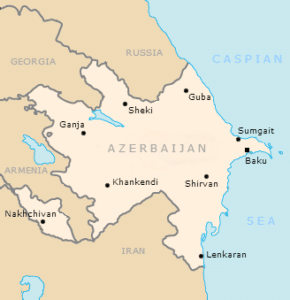
The name Azerbaijan was first adopted for the area of the present-day Republic of Azerbaijan by the government of Musavat in 1918, after the collapse of the Russian Empire, when the independent Azerbaijan Democratic Republic was established. Until then, the designation had been used exclusively to identify the adjacent region of contemporary northwestern Iran,while the area of the Azerbaijan Democratic Republic was formerly referred to as Arran and Shirvan. On that basis Iran protested the newly adopted country name.
During the Soviet rule, the country was also spelled in English from the Russian transliteration as Azerbaydzhan (Russian: Азербайджа́н).
History:
Antiquity:
Petroglyphs in Gobustan National Park dating back to the 10th millennium BC indicating a thriving culture. It is a UNESCO World Heritage Site considered to be of “outstanding universal value”.
The earliest evidence of human settlement in the territory of Azerbaijan dates back to the late Stone Age and is related to the Guruchay culture of Azokh Cave. The Upper Paleolithic and late Bronze Age cultures are attested in the caves of Tağılar, Damcılı, Zar, Yataq-yeri and in the necropolises of Leylatepe and Saraytepe.

Early settlements included the Scythians in the 9th century BCE. Following the Scythians, Iranian Medes came to dominate the area to the south of the Aras. The Medes forged a vast empire between 900–700 BC, which was integrated into the Achaemenid Empire around 550 BC. The area was conquered by the Achaemenids leading to the spread of Zoroastrianism. Later it became part of Alexander the Great‘s Empire and its successor, the Seleucid Empire. During this period, Zoroastrianism spread in the Caucasus and Atropatene. Caucasian Albanians, the original inhabitants of northeastern Azerbaijan, ruled that area from around the 4th century BC, and established an independent kingdom.
From the Sasanid Period to the Safavid Period:
The Sasanian Empire turned Caucasian Albania into a vassal state in 252, while King Urnayr officially adopted Christianity as the state religion in the 4th century. Despite Sassanid rule, Albania remained an entity in the region until the 9th century, while fully subordinate to Sassanid Iran, and retained its monarchy. Despite being one of the chief vassals of the Sasanian emperor, the Albanian king had only a semblance of authority, and the Sasanian marzban (military governor) held most civil, religious, and military authority.
In the first half of the 7th century, Caucasian Albania, as a vassal of the Sasanians, came under nominal Muslim rule due to the Muslim conquest of Persia. The Umayyad Caliphate repulsed both the Sasanians and Byzantines from Transcaucasia and turned Caucasian Albania into a vassal state after Christian resistance led by King Javanshir, was suppressed in 667. The power vacuum left by the decline of the Abbasid Caliphate was filled by numerous local dynasties such as the Sallarids, Sajids, and Shaddadids. At the beginning of the 11th century, the territory was gradually seized by waves of Oghuz Turks from Central Asia. The first of these Turkic dynasties established was the Seljuk Empire, who entered the area now known as Azerbaijan by 1067.
